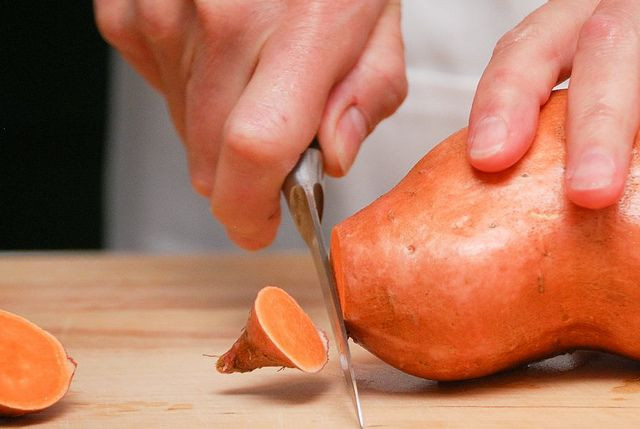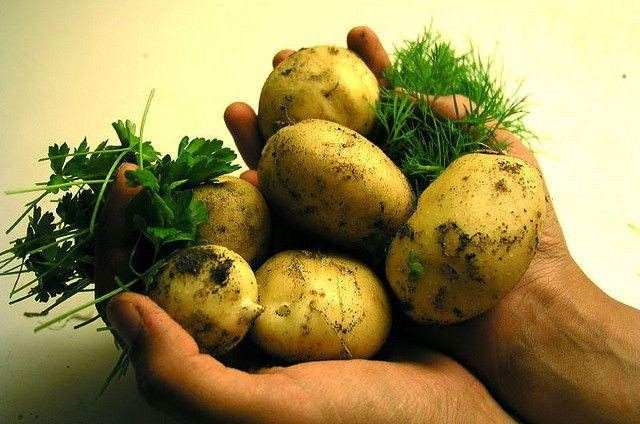Sweet Potato vs. Regular Potato: Which Is Better For Your Health?

Who doesn’t love spuds? Potatoes are the fourth most-consumed food crop in the world, the United States Department of Agriculture (USDA) estimates, after rice, wheat, and corn. Despite its obvious popularity, this starchy staple often gets a bad rap from dieters, and over the past decade or so, sweet potatoes have been touted as the regular potato’s healthier cousin.
So, is there any truth to this claim? Medical Daily investigated.
Let's Begin with Context
Both potatoes and sweet potatoes originate in South America (thank you, Peru and Bolivia), yet they are only distantly related, arising from different plant families. That said, both are considered root vegetables. The potato is hardier, able to be grown in various climates and soil types, while the sweet potato is unable to tolerate frost and is more sensitive to daylight. Commonly, the potatoes sold to consumers have coats appearing in shades of brown or red and white flesh, while sweet potatoes generally have rougher brown coats with orange flesh. However, individual varieties of each come in many different colors and some sweet potatoes even bear white flesh.

The USDA calculates potatoes to be the leading vegetable crop in the U.S. About half the crop each year is sold to processors and transformed into French fries, chips, dehydrated potatoes, and other products, while the other half is sold on the market. Though the American consumer still prefers regular spuds by far, the USDA observed sweet potato production escalating over the past 15 years. Between 2000 and 2014, North Carolina, the highest producing state, saw an increase in production by 185 percent, while Mississippi and California clocked production increases of 155 percent and 100 percent, respectively.
Production facts are rarely contested, yet when it comes to nutrition, there are at least two schools of thought.
Gram Serving or Medium-Size?
While LiveStrong bases its estimates on 100 gram servings of each (skin included), the USDA bases its estimates on a single “medium-sized” food product. By the USDA method, a medium-sized regular (white) potato is generally heavier than its rival and weighs in at 173 grams compared to just 114 grams for a medium-sized sweet potato. This, then, skews all their numbers. By LiveStrong’s count, the two products are indistinguishable in terms of calories: a 100 gram serving of baked white potato (with the skin) contains 93 calories, while the same sized serving of a baked sweet potato (with the skin) contains 90 calories. By the USDA method, though, a medium potato contains 170 calories, versus just 105 in a medium sweet potato.

Continuing by the government's method (hey, you've got to pick a side), the two products are more or less equal in terms of fiber, while the sweet potato, as its name implies, has considerably more sugar. A medium-sized sweet potato has 13 grams of sugar compared to just 2 grams in a medium-sized potato. Carbohydrates and protein, though, are more plentiful in the regular potato, which boasts 37 grams of carbs and 5 grams of protein versus 24 grams of carbs and 2 grams of protein in a sweet potato.
Both regular and sweet potatoes offer you equal amounts of calcium, good for your bones, with both containing 4 percent of your daily requirement. Nearly equal amounts of vitamin C can be found in each: 35 percent for the regular potato and 37 percent for the sweet potato. However, a sweet potato offers a whopping 438 percent of vitamin A (good for your eyes) while you will get none (zilch!) of this vitamin from a regular potato. In terms of iron, a regular potato provides 10 percent of your daily need, while a sweet potato only offers 4 percent. Though the USDA does not calculate potassium, regular potatoes offer more of this nutrient which helps control your blood pressure, according to the Cleveland Clinic, than do sweet potatoes.
So, which food wins the health challenge? Both foods, eaten in their entirety and not spoiled by fattening toppings or unhealthy preparation (frying), are good for you. The one you choose depends on taste and personal dietary needs. If you need more vitamin A for the day, go with the sweet potato. Want more protein and potassium? Go with the regular spuds.
In the end, the sweet potato and regular potato have plenty to offer and both taste delish. Medical Daily officially concedes defeat.



























